Q&A – Ask Neil: August 31, 2023
(Please read these instructions carefully.)
Before you post your question, please look at recent issues to see if someone else has already asked it. You might find your answer there.
How to submit your question…
(Note: You may need to allow a pop-up window to come up in order to get the link for sending your photo(s). If you have already submitted your question and didn’t see the pop-up window, please click here.)
• Click the link provided below to post your question. After you submit your question, a new window will pop up giving you the address to which you can e-mail a SHARP, HIGH-RESOLUTION PHOTO to accompany your question. Please DO NOT SEND THUMBNAIL PHOTOS in case I need to zoom in to see things.
• Click here to post your question.
• Please ONLY POST YOUR QUESTION ONE TIME. We can only accept a set number of questions each week, and when we get duplicates it costs other people their chances.
• One question per reader, please.
• Please use this only for posting questions – not for standard emails.
• Watch for your answer in the following week’s e-gardens.
• I choose those of greatest general interest. For example, plant IDs seldom make the cut.
• I must have your first name or initials.
• I must have your city or county. (Texas is a very large state.)
QUESTION 1
HOW DO I REHAB A SUN-SCORCHED LAWN NEXT YEAR?
Question: How do I rehab a sun-scorched dead lawn next spring? Plugs work? Remove dead grass and stolons? Bermuda vs. current St. Augustine? I have shallow soil – 2 to 3 inches before hitting caliche. Jon W., Bell.
Answer: I’m in a quandary. I don’t know if you’re in Bells, Texas, or Bell County, Texas. St. Augustine would be safer if it could be planted farther south (Bell County) due to its somewhat warmer winters. Bells gets very cold. I live in rural Collin County near you to the south and I’ve had damage to my Raleigh St. Augustine a couple of winters.
In either case, common bermuda would probably be your better choice, and seeding it mid-May next year would be the least expensive way of getting it started. It’s drought-tolerant and completely winter-hardy either place. I will admit that I succumbed to have about half an acre sodded this year simply because I feared erosion on our hillside.
For the record, St. Augustine grows best in full sun. However, it does require more water than bermuda. And, as I’ve mentioned in several stories here over the past three months, chinch bugs have been ravaging St. Augustine in sunny sites. People have wrongly assumed it was the sun when the insects were actually to blame.
QUESTION 2
WHAT CAN I DO WITH SPURGE?
Question: Spurge weed is overtaking my lawn. Help! Terry B., Plano.
Answer: Spurge is one of those “weeds of neglect.” It shows up when our turfgrass is “thirsty” or “hungry.” While you can control it with a broadleafed weedkiller spray containing 2,4-D, that’s equivalent to taking an aspirin while you continue banging your head into a wall. Step up your lawn care just a bit and the spurge will soon be crowded out.
QUESTION 3
WHY WOULD ONE CAROLINA JESSAMINE DIE?
Question: What would cause only one Carolina jessamine to die? All have had the same amount of water. They get morning and early afternoon sun. Photo is from three weeks ago. Phyllis S., Dallas.
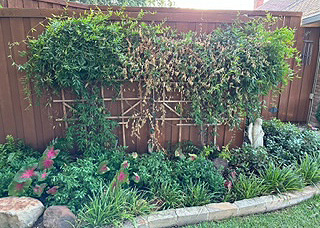
Answer: Oh, I have felt your pain. I’ve had the same thing happen years ago. Best I could ever tell it was because something bumped into the stem and cracked it. Your photo is low-res, so I couldn’t zoom in enough to see if the stem is up against any kind of support. If not, examine it closely to see if you can detect any type of hairline crack. The only other possibility I can think of would be the soil-borne fungus cotton root rot, but I doubt if that would get one in the middle and not very quickly get one or the other of the side plants.
QUESTION 4
WHAT HAS CAUSED DEFOLIATION OF DESERT WILLOWS?
Question: During the wet springs of 2021 and 2023 we have seen heavy leaf spot and defoliation of our five desert willows. The tops fare better than the bottoms. We have not sprayed them because of bee activity. Any suggestions? Jeannette P., Abilene.
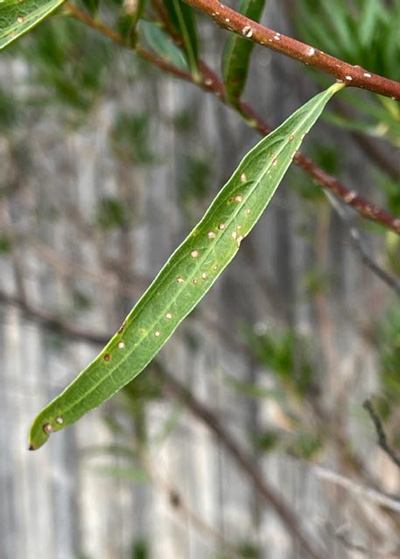
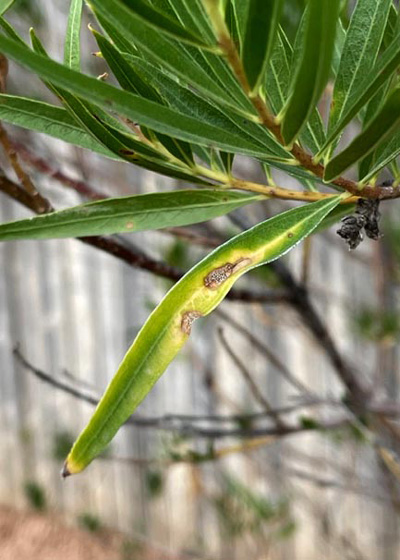
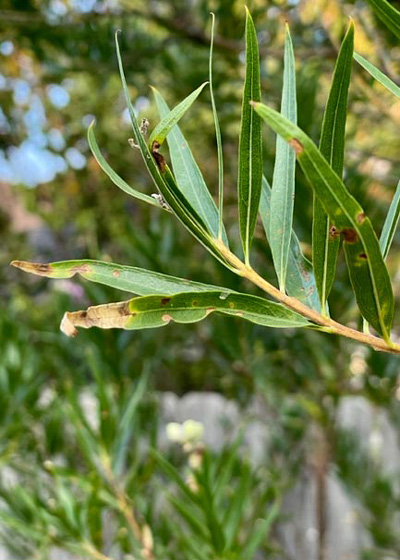
Answer: I’m unfamiliar with any common leaf spot diseases with desert willow (Chilopsis linearis, in case you want to do any web-searching). With 20 minutes of searching online myself I didn’t find any southwestern university write-ups that spoke of diseases of importance.
Let me try to come up with an answer. Let’s assume it is a fungal leaf spot. I would visit with a Texas Certified Nursery professional and ask that he or she show you a couple of general-purpose fungicides listing broad assortments of leaf spots. I don’t think you’re going to find desert willow on any product’s label, so you’re going to have to do a little trial and error on your own next spring (too late this year). Better yet, you might have a fungicide in your own arsenal already, so you could save yourself the purchase.
The other thing that crossed my mind was that those two springs were not, where I live, especially wet. What did set them apart was that they followed extremely cold winters. February 2021 did a huge amount of damage to desert willows in DFW, and perhaps it weakened them in Abilene as well. This past Christmas we had another extreme cold spell that did more harm, although not so much to desert willows that I have observed. However, I haven’t seen nearly as many blooming profusely in the past three years as normal.
If you still feel it is disease-related, you might consider sending a sample to the Texas Plant Disease Diagnostic Lab at Texas A&M. They do charge to culture samples, but you could find out for sure. I would just hate to see you spend money and end up with an ID of what was essentially a harmless fungus.
QUESTION 5
WHAT HAPPENED TO MY GOLD DUST AUCUBA?
Question: On the advice of a local nursery, we planted Gold Dust aucuba bushes in early April. The location faces north, so it does not get a lot of sunlight. It did well for several months, but now the leaves are wilting and turning black. Why? Can it be saved? David T., Plano.

Answer: There are only two possibilities. Either the angle of the sun has changed, and the sun now hits the plant, or the plant has gotten too dry one or more times. Aucubas absolutely do not tolerate direct sunlight at all. If they grow at the corner of a house and poke their branches around the corner into any amount of sun, they will look like they’ve been torched right where the sun hits their foliage. However, you’ll notice that the outer-most leaves on you plant are not the ones that are blackened the worst. That pretty much rules out sun damage and takes us to the next consideration.
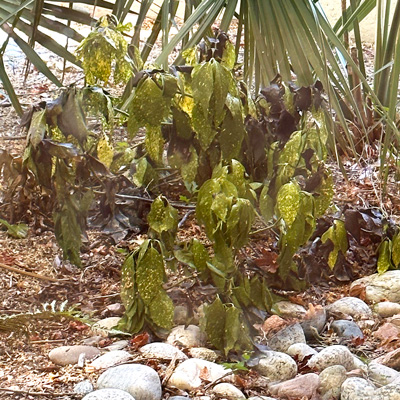
The second possibility is drought. I’m in one hallway a couple of times a week where I see a similar thing going on. I know this plant in the second photo is just dry. There is absolutely no sunlight hitting it – just a ton of drought. Sadly, I don’t think it, or your plant, will recover.
I have several Gold Dust aucubas in my landscape at home. They vary in age from 25 to 35 years, which means they’ve survived some really bad weather. It’s all about the sun and irrigation during the dry spells. As with all other new plants, any new shrub would need to be watered by hand every other day during such extremely hot times.
QUESTION 6
WHAT IS HAPPENING TO OUR MAGNOLIA TREE?
Question: What is happening to our beautiful magnolia tree? It looks like the whole tree is turning brown. It’s dropping leaves. It’s being watered by our sprinkler system. It looks scorched, but we’ve had hot summers before and this hasn’t happened. Joe A., Dallas.
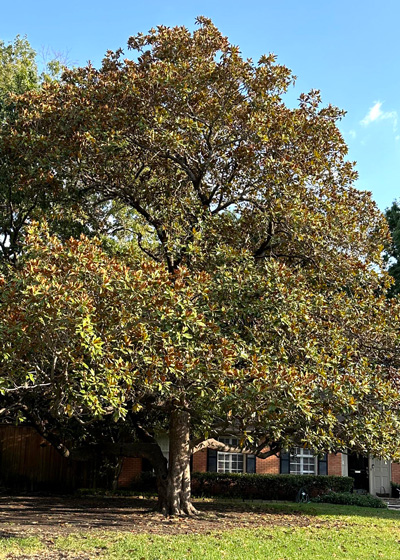
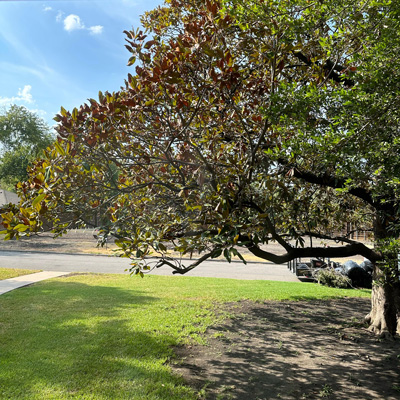
Answer: I’m answering the Q&A section of e-gardens last this week, which means I’ve already written the story about “Call After Call” in which I referred to this exact topic. Your photo is far more meaningful than the one I used.
I’ll start with this issue of water. It does look like your tree should have been getting enough water from the sprinkler system as judged by the St. Augustine and your shrubs. But you won’t hurt it by laying a soaker hose out around the drip line (where the grass begins). (It looks like you might have some chinch bug activity.)
Have you used, or did anyone use for you, a weed-and-feed product containing Atrazine? It does this kind of damage to magnolias, so much so that disclaimers are put on some product labels about not using it on St. Augustine turf in the DFW area’s black clay soils. It usually causes a rolling of the leaves. I can’t see that in either of your photos, but just know that magnolias are especially sensitive to weed-and-feed products. They are precisely why I won’t recommend or accept ads for them. I’ve seen too much damage.
The third thing that comes to mind brings up a very bad memory. I rarely have done consulting work, but on one occasion in the early 1970s I was working at the house of a name everyone reading would recognize. That family had two very large magnolias that they used as outdoor Christmas trees, and one of them became very sick very quickly. I called in all the help I could find. Plant Pathology at Texas A&M cultured it and found the cause to be Nectria canker (now may go by the genus Neonectria). Sadly, there was no control, and that tree was gone within a couple of weeks. I’ve only seen that disease a couple of times, so I don’t want to alarm you. I just thought I’d better mention it.
I would recommend you hire a certified arborist to look at your tree on site. If I were in your shoes I would contact my advertiser here in e-gardens in a heartbeat.
QUESTION 7
WAS THIS JUST A BAD YEAR FOR TOMATOES?
Question: Was this year just too hot for tomatoes, or did I get bad plants from the big box store? Or maybe I was expecting too much from my 5-gallon bucket. I planted Cherokee Purple, as I have in the past in a raised bed. It produced several small tomatoes that shriveled. Frank G., Denton.
Answer: Let me start with variety selection. Choose a small to medium-sized variety. You chose an old heirloom very large tomato. There is a physiological tie between fruit size and ability to set fruit at high temperatures. Large varieties like Big Boy, Beefsteak, and your Cherokee Purple, won’t set fruit when it goes above 90F.
Hybrid varieties will out-produce the heirlooms severalfold. Some will contend that the old varieties have better flavor, but that’s not a certainty, plus, if they’re not setting fruit in the first place it’s pretty much moot.
You need at least a 7-, preferably a 10-gallon container to grow tomatoes successfully. They use a great deal of water, and you just can’t keep up with their demands in 5-gallon pots.
Next time try varieties like Super Sweet 100, Red Cherry, Yellow Pear, Porter, Roma, Early Girl, Super Fantastic and Celebrity. And buy them from a local independent retail garden center or feed store.
